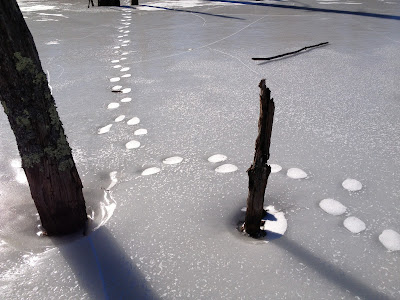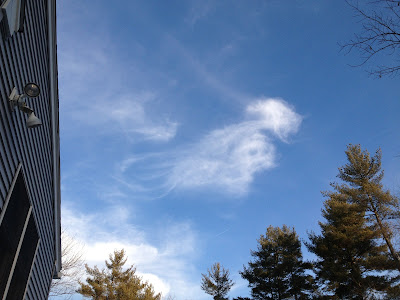We've had more than a week of continuous below freezing temperatures, with a few nights dipping down below zero degrees Fahrenheit. This cold snap arrived on the heels of a January thaw. The thaw turned snow into slush and melted pond ice, making it thin and dangerous for crossing. This recent cold spell has caused wetlands and waterways to freeze up solid. The wetland behind our house is rock hard, the ice thick and opaque. It's been many winters since we've had such great wetland walking conditions. With a warming trend ahead, we spent as much time out on the ice as possible these past few days, bundled against the cold winter wind.
Day after day this past week, as the sun and wind whisked away snow cover, the ice froze ever deeper. A frozen wetland suddenly offers a whole network of trails (stream channels in ice-free periods) and places to explore. So I explored, walking among the hummocks of tussock sedge and between thickets of alder and buttonbush, with relative ease.

Animals that hunt below the ice, among the sedge hummocks, or along the wetland edge, leave signs of their meals behind. I found an otter latrine on a snow-covered mound of tussock sedge, so noted by the piles of scat filled with fish scales, the main winter diet of river otter. While walking in the middle of a frozen pond along the Sweet Trail, we passed a large exposed rock, with small piles of muskrat scat. The dark cylindrical droppings appeared to be filled with bits of vegetation, likely cattail, bulrushes and other aquatic plants. In the middle of the frozen wetland channel behind our house I looked down at two pea-sized, Army green droppings. I consulted
Mary Holland, author of Naturally Curious. She suggested mourning dove droppings, and I think she is right.
If you aren't interested in the fine details and clues waiting to be discovered in animal droppings, then there are plenty of other wonderful things to see and hear while wetland walking.
Under a winter's sun, frozen ponds and lakes boom and yelp and screech as ice expands and contracts. I remember one of the first times I heard a frozen lake boom in the Boundary Waters of northern Minnesota. We thought the lake would open up and swallow us. Mostly though, frozen wetlands are still and silent and beautiful, especially under a winter's clear blue sky. The sun casts long shadows and the wind creates patterns in the ice and snow. Plants are frozen in place. All arranged as if in a series of still-life paintings.
The Sweet Trail, that stretches four miles from Newmarket to Durham in southeastern New Hampshire, meanders past a series of large beaver-influenced wetlands. During one of our recent winter walkabouts we veered off the woodland trail and onto the wetlands, walking across frozen ice and stepping over beaver dams to reach the next flowage.
We wandered among a colony of great blue heron nests, which sit idle, waiting for the return of the large, graceful birds after Spring thaw. Their nests seem perched precariously atop the dead trees, especially as seen up close in winter. Many of the standing dead trees in this wetland have lost their top-most branches, limiting their appeal to herons. In time, this colony will need to search out a new wetland that has suitable tree-tops.
Kodi and I took a long walk on the wetland this morning. It could be the last wetland walk for awhile, as another winter thaw is on its way. An animal's track left during the last thaw is locked in the frozen ice. Those tracks will likely melt away this week, along with our wetland walks.















































